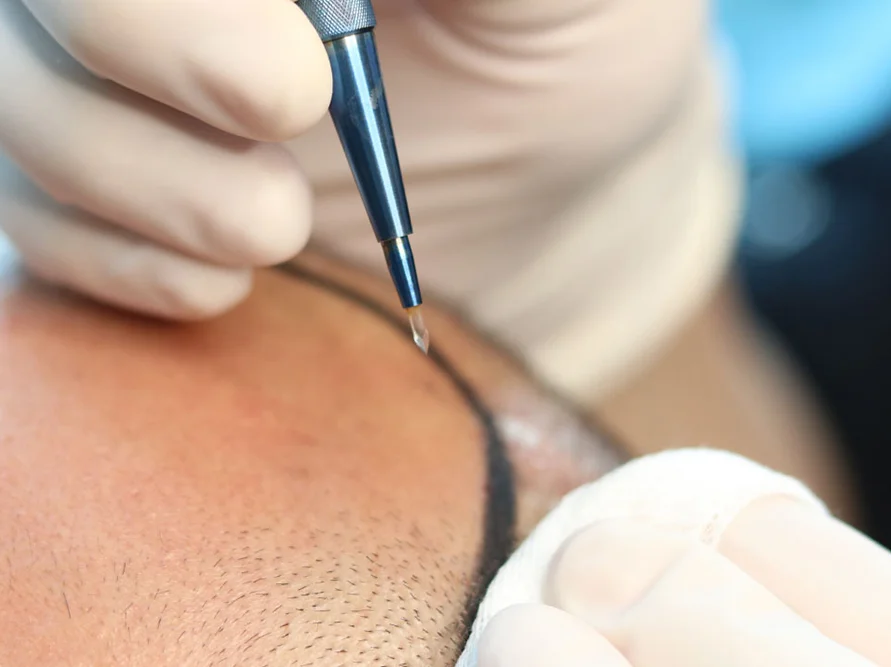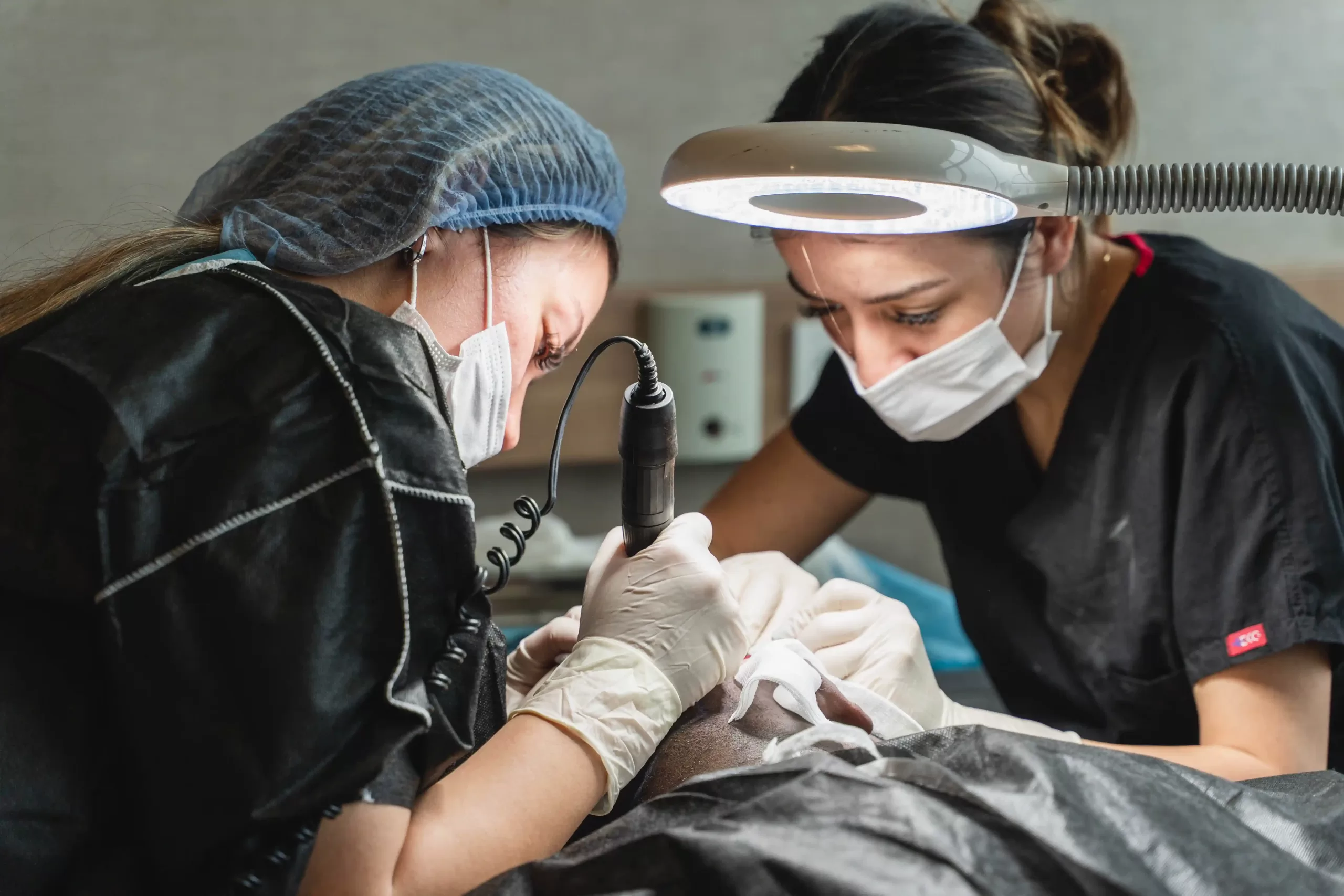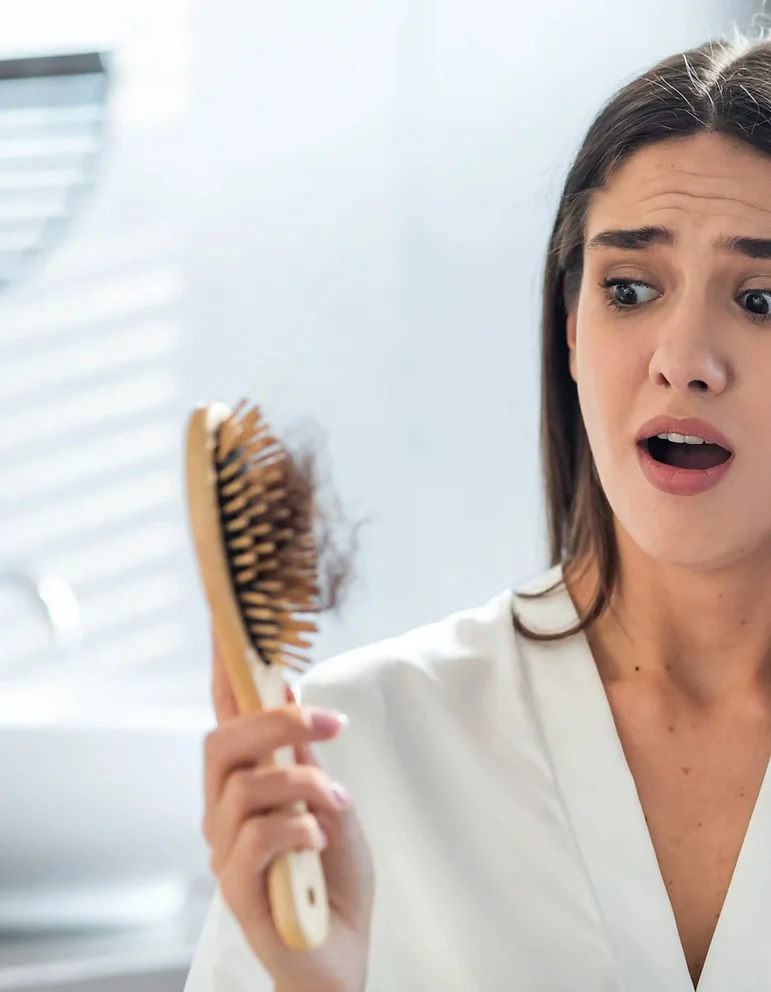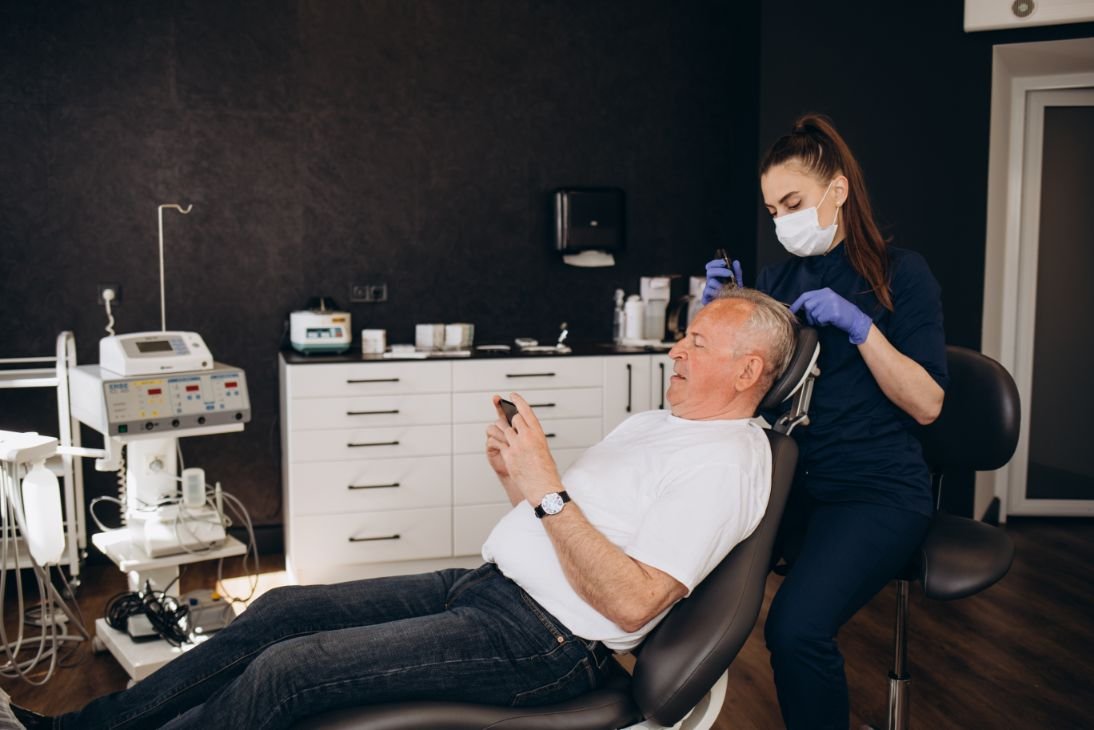FUE TECHNIQUE
Hair transplant is a transformational procedure that can renew your self-confidence and improve your appearance.
One popular method is the Follicular Unit Extraction (FUE) hair transplant.
This technique involves the extraction of individual hair follicles from your skin, which are then transplanted to a part of your body where the hair is thinner or absent.
The FUE method offers several benefits, one of which is minimal scarring.
It relies on a small, circular punch tool rather than a linear incision for the extraction of the follicles, which leads to quicker recovery times and more natural-looking results.
FUE TECHNIQUE ADVANTAGES
The sapphire FUE technique is a variation of the standard FUE (follicular unit extraction) method of hair transplant surgery. In the sapphire FUE technique, a special Sapphire-tipped punch tool is used to extract the hair follicles from the donor site.
The Sapphire material is smooth and hard, which allows the punch tool to glide smoothly through the skin and minimize trauma to the surrounding tissue.
This can result in less to zero swelling, bleeding, and discomfort during and after the procedure.
The Sapphire FUE technique is also known for producing natural-looking results and minimal scarring.
The sapphire material is smooth and hard, which allows the punch tool to glide smoothly through the skin and minimize trauma to the surrounding tissue.
This can result in less to zero swelling, bleeding, and discomfort during and after the procedure.
The sapphire FUE technique is also known for producing natural-looking results and minimal scarring.

WHO IS THE BEST CANDIDATE FOR HAIR TRANSPLANT?
Hair transplant surgery works best for individuals with stable hair loss patterns, such as male or female pattern baldness. It can also be beneficial for individuals who have experienced hair loss due to trauma or medical treatments.

Manual punch tool
Manual punch tool FUE is a traditional approach to hair transplantation. In this method, a specialized cylindrical tool, known as a punch, is manually used by the surgeon to extract individual follicular units from the donor area.
While the procedure is more labor-intensive and time-consuming compared to other methods, it offers a high level of precision. The surgeon can control the angle, depth, and direction of each punch, reducing the risk of transection and damage to the follicles. This method can be an excellent option for patients with a small area of hair loss or those who are ideal candidates for body hair transplantation.
However, manual punch FUE requires an experienced surgeon with a steady hand and an excellent understanding of hair growth patterns to achieve the best possible results. Clinics like CADES Clinic, known for their expertise in manual punch FUE, can ensure patients receive the most effective treatment tailored to their unique needs. Their unwavering commitment to patient care and their reputation for excellence makes them a trusted choice in the field of hair transplantation
Manual punch tool
Manual punch tool FUE is a traditional approach to hair transplantation. In this method, a specialized cylindrical tool, known as a punch, is manually used by the surgeon to extract individual follicular units from the donor area.
While the procedure is more labor-intensive and time-consuming compared to other methods, it offers a high level of precision.
The surgeon can control the angle, depth, and direction of each punch, reducing the risk of transection and damage to the follicles.
This method can be an excellent option for patients with a small area of hair loss or those who are ideal candidates for body hair transplantation.
However, manual punch FUE requires an experienced surgeon with a steady hand and an excellent understanding of hair growth patterns to achieve the best possible results.
Clinics like CADES Clinic, known for their expertise in manual punch FUE, can ensure patients receive the most effective treatment tailored to their unique needs.
Their unwavering commitment to patient care and their reputation for excellence makes them a trusted choice in the field of hair transplantation
What Causes Hair Loss?
Hair loss, a common concern across both genders can be triggered by numerous factors ranging from lifestyle choices to underlying medical conditions. It is crucial to understand that hair loss is not merely a cosmetic issue but often a complex interplay of various aspects of one’s health and well-being. Let’s delve into the main causes of hair loss:
Telogen Effluvium: Imagine a situation where your hair follicles decide to take an extended vacation. That’s precisely what happens in Telogen Effluvium. Due to physical or emotional stress, childbirth, drastic weight-loss, surgery, or certain medications, hair follicles prematurely enter the resting phase, halting new hair production. This shift results in an increased amount of hair shedding and hair appears thin all over the scalp.
Alopecia Areata: In this condition your immune system turns against your hair follicles, mistaking them for foreign invaders. This autoimmune attack shrinks the follicles, making them stop producing new hair, leading to patchy hair loss.
Trichotillomania: This disorder is often driven by stress or anxiety, where individuals cope by compulsively pulling out their own hair. The result can be visibly patchy areas of hair-loss on the scalp or other areas of the body.
Nutrient Deficiency: Just as plants wilt without proper nutrients, your hair can suffer too, if your diet lacks certain elements. Deficiencies in iron, protein, or specific vitamins can lead to hair thinning and loss.
Underlying Medical Conditions: Some health conditions like thyroid disease, lupus, or polycystic ovary syndrome (PCOS) can also precipitate hair-loss as part of their symptom profile.
Medication Side Effects: Unfortunately, some medications meant to treat health issues can also cause hair loss. Examples include chemotherapy drugs for cancer, blood thinners, and certain types of antidepressants.
What Cause Hair Loss?

Advantages of Hair Transplant for Women
Hair transplants can yield very natural-looking results since the transplanted hair is your own.
This method offers long-lasting results as the transplanted hair follicles are resistant to the hormones that cause hair loss.
Moreover, hair transplants can correct specific hair loss patterns and significantly boost self- esteem.

What Causes Hair Loss for Women?
Hair loss in women, although less discussed, is a prevalent concern. It can be prompted by a variety of factors, often differing from those that affect men. Understanding these causes can help in determining the best way to address the problem:
Genetic Predisposition: The most common cause of hair loss in women is androgenetic alopecia, also known as female pattern hair loss. This condition, influenced by both genetics and hormones, typically results in a diffuse thinning of hair across the entire scalp.
Hormonal Changes: Women’s bodies go through significant hormonal shifts throughout their lifetime, including during pregnancy and menopause. These hormonal fluctuations can sometimes trigger temporary hair-loss. Even hormonal imbalances from conditions like polycystic ovary syndrome (PCOS) can result in hair thinning.
Medical Conditions: Various medical conditions can contribute to hair loss in women. For instance, iron deficiency anemia, which is more common in women, can lead to hair-loss. Similarly, disorders of the thyroid gland can disrupt the hair growth cycle, causing hair to thin or fall out.
Medications: Some medications can have hair loss as an unintended side effect. These can range from certain antidepressants and blood thinners to birth control pills.
Hairstyling Practices: Certain hairstyles that pull tightly on the hair, such as ponytails, braids, or hair extensions, can lead to traction alopecia, a type of hair-loss caused by constant pulling and tension on the hair follicles.
Physical or Emotional Stress: Stressful life events, either physical or emotional, can induce a type of hair-loss called telogen effluvium. This condition is characterized by a general thinning of the hair several months after a stressful event.
What Causes Hair Loss for Women?
Hair loss in women, although less discussed, is a prevalent concern.
It can be prompted by a variety of factors, often differing from those that affect men. Understanding these causes can help in determining the best way to address the problem:
Genetic Predisposition: The most common cause of hair loss in women is androgenetic alopecia, also known as female pattern hair loss.
This condition, influenced by both genetics and hormones, typically results in a diffuse thinning of hair across the entire scalp.
Hormonal Changes: Women’s bodies go through significant hormonal shifts throughout their lifetime, including during pregnancy and menopause.
These hormonal fluctuations can sometimes trigger temporary hair loss. Even hormonal imbalances from conditions like polycystic ovary syndrome (PCOS) can result in hair thinning.
Medical Conditions: Various medical conditions can contribute to hair loss in women. For instance, iron deficiency anemia, which is more common in women, can lead to hair loss. Similarly, disorders of the thyroid gland can disrupt the hair growth cycle, causing hair to thin or fall out.
Medications: Some medications can have hair loss as an unintended side effect.
These can range from certain antidepressants and blood thinners to birth control pills.
Hairstyling Practices: Certain hairstyles that pull tightly on the hair, such as ponytails, braids, or hair extensions, can lead to traction alopecia, a type of hair loss caused by constant pulling and tension on the hair follicles.
Physical or Emotional Stress: Stressful life events, either physical or emotional, can induce a type of hair loss called telogen effluvium.
This condition is characterized by a general thinning of the hair several months after a stressful event.

